College Football’s All-Time Wins Leader Is Retiring
http://www.gojohnnies.com/news/2012/11/19/FOOTBALL_1119125657.aspx
COLLEGEVILLE, Minn. – Saint John’s University (Minn.) legendary football coach John Gagliardi announced his retirement on Monday, Nov. 19.“Seventy years (60 at SJU) is a long time to be doing the same job,” Gagliardi said. “Luckily, I’ve always been blessed with great players, friends, family and support to make it this far.
“Nobody ever said that getting older was easy. I just can’t do the job at the level I used to anymore.”
SJU (5-5, 3-5 MIAC) ended its 2012 season with a 27-22 loss Nov. 10 at Bethel.
Gagliardi will remain on staff until his current contract expires June 30, 2013. The search process for his replacement begins immediately.
“Arguably, John Gagliardi has impacted the lives of as many young men as any individual in the history of Saint John’s University,” SJU President Dr. Michael Hemesath said. “His legacy of educating young men at Saint John’s is one that any coach or professor would envy.
“The kind of loyalty and commitment John showed to Saint John’s and his student-athletes is rare and exemplary. It is an example of how John modeled good character and ethical behavior for his student-athletes and the community for 60 years.”
The first active head coach to be inducted into the College Football Hall of Fame (Class of 2006) and the 2009 American Football Coaches’ Association (AFCA) Amos Alonzo Stagg Award recipient, Gagliardi (Guh-lahr-dee) ended his record 64th season as a collegiate head football coach and 60th season as head coach of the Johnnies this fall. The winningest coach all-time in college football history, Gagliardi ends his storied career with a 489-138-11 (.775) collegiate record and a 465-132-10 (.774) record at SJU, including a 362-99-9 (.780) record in Minnesota Intercollegiate Athletic Conference (MIAC) games. Gagliardi’s 64 years of collegiate coaching is the most in college football history, surpassing the old record of 57 years held by former University of Chicago and University of the Pacific coach Amos Alonzo Stagg (1890-1946).
“Today is another milestone for the greatest head coach in the history of college football,” SJU Athletic Director Tom Stock said. “We are so very happy and proud of John, and those of us who have been associated with him are so fortunate that he chose to spend his life and career at Saint John’s, building a model NCAA Division III football program.
“I witnessed him spending his days passionately doing what he loved, coaching college football and mentoring young men. And, because it was such a passion for him, no one has ever done or will ever do it better.”
The 2007 Liberty Mutual Division III Coach of the Year, Gagliardi tied the all-time collegiate win record, held by former Grambling State head coach Eddie Robinson, on Nov. 1, 2003, and broke the all-time record on Nov. 8, 2003, en route to a perfect 14-0 season and an NCAA Division III championship, one of four national titles he won at SJU. Gagliardi also broke Robinson’s record for the most games coached in college football history (588) in 2008 and coached his 600th game in 2009.
Gagliardi coached four national championship teams (1963, 1965, 1976 and 2003), and made the 2000 national title game. His teams reached the national semifinals six other times (1989, 1991, 1993, 1994, 2001 and 2002). As a collegiate coach, Gagliardi’s teams won 30 conference titles (including three at Carroll, Mont.) and appeared in 58 post-season games. In the past 44 years, SJU was nationally ranked 43 times and owned a 39-19 postseason record. In 1993, SJU averaged 61.5 points per game, setting an all-divisions record that may never be broken.
Gagliardi’s coaching career began when his high school coach at Trinidad (Colo.) Catholic was drafted into World War II. As the team’s captain, Gagliardi took over the reins at the age of 16 in 1943. His teams won four conference titles in six years of coaching high school at Trinidad Catholic and later, at St. Mary’s in Colorado Springs.
After graduation from Colorado College in 1949, Gagliardi began his first college coaching position at Carroll College in Helena, Mont. The college explored the possibility of dropping football because of losing seasons and lack of interest. Gagliardi led Carroll to three conference titles in his first four seasons and won conference championships as head coach of the basketball and baseball programs.
His success caught the attention of Saint John’s, which needed a coach to succeed the legendary Johnny “Blood” McNally, a charter member of the National Football League Hall of Fame. Compared to Carroll, the SJU football program was healthy before Gagliardi’s arrival, but not exactly thriving. SJU had not won a conference title in 15 years. Gagliardi took over the program in 1953. Meanwhile, Blood offered this gloomy prediction: “Nobody could ever win at Saint John’s.” Gagliardi proved McNally wrong by winning the MIAC title that fall.
Aside from the football field, Gagliardi also won two conference championships with SJU’s track team and coached the SJU hockey team for five seasons from 1954-59, compiling a 42-25-1 record. The .625 winning percentage is still the best of any hockey coach in school history. In addition to his various head coaching duties, Gagliardi has also been athletic director at both Carroll (1949-53) and Saint John’s (1976-94). In June 2006, Gagliardi was inducted into the National Association of Collegiate Directors of Athletics (NACDA) Hall of Fame.
In 1993, Josten’s and the SJU J-Club unveiled the Gagliardi Trophy, which is awarded to the nation’s outstanding Division III player on the basis of excellence in athletics, academics and community service.
Gagliardi’s success is attributable to more than just football strategy and tactics. He created an environment of fun and high expectations, which concentrated on methods and practices that truly focused on winning football games. His coaching methods have been distilled into a series of “Winning With No’s,” which were unveiled in the 1960s.







